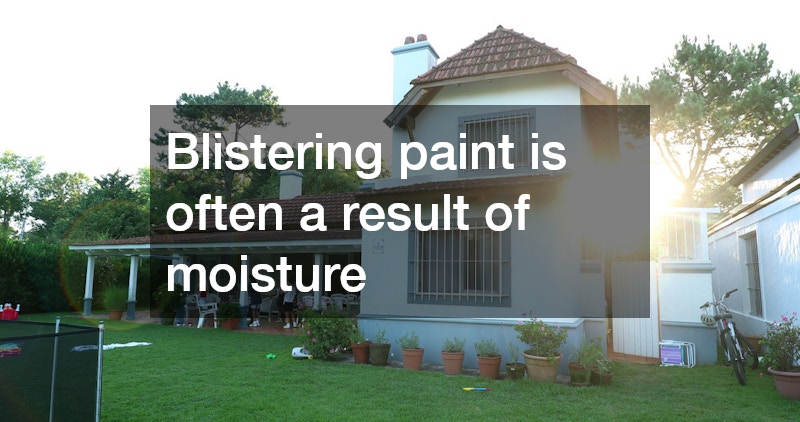The exterior of your home is the first thing people notice, and maintaining its appearance extends beyond aesthetics. Proper exterior painting safeguards the home against elements and enhances property value. Discover the key indicators that signify it’s time to consider an updated exterior painting.
Visible Signs Your Paint Needs Updating
Peeling, cracking, or blistering paint are clear indicators that your home requires a fresh coat. These signs suggest that the current paint is failing to protect your home while allowing moisture and elements to potentially damage the underlying surfaces.
When paint begins to peel or crack, it exposes the underlying materials to the elements, significantly increasing the risk of water damage and rot. Over time, neglecting these issues can lead to costly repairs, which far exceed the expense of a new paint job. Furthermore, peeling and cracked paint detracts from the overall appearance of your home, making it look neglected and uncared for.
Blistering paint is often a result of moisture being trapped underneath the surface. This can happen if paint is applied in direct sunlight, on a damp surface, or without adequate preparatory work. Blisters compromise the paint’s ability to protect your home effectively, leading to further deterioration. Addressing blistering paint promptly can prevent further damage and ensure that your home remains in good condition.
Age and Quality of the Current Paint
The longevity of exterior paint varies based on the initial quality and environmental conditions. Generally, after 5-10 years, most homes begin showing wear. Inspect your home’s paint for chalking, fading, or general wear as age-related indicators for an update.
High-quality paint is designed to endure the elements better and often comes with longer warranties from manufacturers. Investing in good-quality paint initially can extend the time between necessary updates, offering better long-term savings. On the other hand, lower-quality paint might need more frequent updates as it tends to wear out faster under similar conditions.
Age-related factors also play a significant role in your decision to repaint. As the paint ages, it often loses its elasticity, making it prone to cracking and bubbling. Older paint may not only present a less vibrant color but also lose its ability to protect the structure effectively from weather-related wear, moisture ingress, and UV damage.
The Influence of Weather Conditions
Harsh weather conditions, such as extreme sunlight, heavy rainfall, and salty air, can accelerate the breakdown of exterior paint. Homes in such climates often require more frequent maintenance to protect against these elements.
In regions with high UV exposure, paint tends to fade and degrade faster due to the constant bombardment of sunlight. UV rays break down the paint’s binder, causing the pigments to fade and the paint film to degrade, necessitating more frequent painting to maintain a fresh appearance and adequate protection.
Similarly, homes in rainy or humid climates face challenges with moisture infiltration. Excessive rain or high humidity levels can lead to flaking and peeling paint as the moisture seeps into the wood or masonry, causing the paint film to break away. Regular painting in these conditions ensures the home remains sealed against water damage.
Mold or Mildew Growth
The presence of mold, mildew, or algae can signify that your current paint is no longer adequately protecting your home. These infestations not only degrade the appearance but can also cause structural damage over time, indicating the need for repainting.
Mold and mildew are not only unsightly but also harmful to the integrity of your home’s structure. They thrive in damp, shaded environments and can quickly spread over exterior surfaces if not addressed. Painting with mildew-resistant paint can help combat these issues, protecting your home from further infestation.
Besides causing aesthetic problems, mold and mildew can also affect the health of those living in the home, leading to respiratory issues and allergies. Ensuring that your home is free from mold and mildew waves off potential health risks and keeps your living environment safe.
Curb Appeal
A fresh exterior coat can dramatically enhance curb appeal, which is crucial if you’re preparing to sell. Even if staying, a well-maintained exterior boosts pride in homeownership and potentially increases neighborhood property values.
Updating the exterior paint is one of the most impactful home improvement projects for enhancing curb appeal. A fresh paint job can bring new life to your home’s appearance, catching the eye of prospective buyers and leaving a lasting impression. Bright, well-chosen colors can accentuate architectural features, making your home stand out positively in the neighborhood.
A well-maintained exterior is often a sign of diligent homeownership, portraying a message of care and attention to detail. This can positively influence not only potential buyers but also neighbors, fostering a community of pride and high property maintenance standards.
Regular maintenance and timely painting updates are essential for protecting your home and preserving its value. Being aware of visible signs, climate impacts, and long-term mold issues will guide your decision to invest in updating your exterior paint. Not only does this maintain your home’s structural integrity, but it also ensures that your home remains beautiful for years to come.




